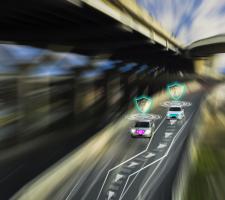
Earlier this year, the UK government made the bold statement that by 2021, driverless cars will be on the UK’s roads. But is this an achievable reality?
Driverless technology already has its use cases on our roads, with levels of autonomy ranked on a scale. At one end of the spectrum, level 1 is defined by the automation of a specific function, with level 5 at the other, where a fully autonomous vehicle (AV) has the ability to independently navigate a route without human input. In reality, most new vehicles are currently at level 1 or 2, with a minority edging into level 3 autonomy such as advanced driver-assistance systems (ADAS) that use cameras to spot hazards before the driver and automatically brake.
In terms of making driverless vehicles commonplace, people fail to understand that cars are actually the most challenging for making fully autonomous. This is mainly a consequence of their frequent interaction with humans and the huge variety of conditions experienced by these types of vehicles.
The development and roll-out of driverless vehicles is not easy. And the 2021 target is certainly an ambitious one. Rather than the technology itself, a plethora of barriers such as insurance, consumer perceptions and the regulatory environment are often cited as the reasons why progression hasn’t been as fast as once hoped. But with other forms of driverless transport being at a more advanced stage, why are designers and engineers of AVs finding it so difficult to execute?
Human traffic
Off-road, the development of driverless vehicles has been far more successful because humans don’t factor into the decision-making process, which means operation is overall much safer. In fact, one scenario where driverless technology is being successfully trialled right now is with dump trucks at UK roadworks. The impact of human interaction with driverless vehicles is so complicated as a result of our unpredictable nature – our actions and movements are difficult to track, meaning the number of different scenarios within which to test driverless technology is much greater to guarantee its safety.
Where people have the greatest potential to disrupt driverless vehicles is if they decide to intentionally test the boundaries or obstruct the movements of these vehicles. One prediction is that people will stand in front of the cars so they stop immediately. To make sure the technology remains safe, even in these situations, developers need to guarantee they can be safely used around humans whilst simultaneously functioning properly, whether humans are cooperating with the technology or trying to intentionally disrupt it.
Greater progress is being made in driverless vehicles needed to carry out repetitive tasks because they are much more straightforward to automate. Take agriculture, with driverless tractors as an example - or mining, where vehicles pick up and transport materials from one part of the site to another location.
Some weather conditions, including heavy snow and rain, tend to cause issues for driverless cars, mainly because it interrupts the sensor technology used to identify markings on the road and signage. In addition, it’s more difficult for driverless cars to safely function in regions where road systems aren’t properly regulated, or if their infrastructure is somewhat limited, because the technology will have to cope with much broader and complicated driving parameters.
AI’s role
When considering the future of AVs and associated systems, artificial intelligence (AI) has a massive role to play. Take machine learning: this form of AI can be used for teaching a system to recognise specific features in images or data. But a lack of transparency or the ‘black box’ issue can throw a spanner in the works. Given the required safety standards, the automotive sector is very tightly regulated, so manufacturers need to ensure their systems can be properly tested and certified. This means that any AI algorithms incorporated in the driverless vehicle technology must be comprehensible by a human.
When designing autonomous systems including driverless cars, testing is an essential part of the process. But when you are limited to just real-world testing, it is impossible to fully trial a system because there are too many possible scenarios to even think of that a car might encounter on the road. This is where the correct modelling technology has a key role to play for developers of driverless vehicles to overcome this issue.
The good news is that there are a multitude of flexible development tools on offer to engineers.
From designing and choosing the right sensors to those that develop and deploy algorithms for vehicle perception (for example, simulation and controls system design tools such as Simulink), as well as verification, validation and deployment tools - these technologies cover the entire development lifecycle of autonomous systems.
For recreating the countless situations driverless vehicles may encounter in the real world, the aforementioned tools can cover the entire development lifecycle of autonomous systems. The testing stage can be incredibly expensive and resource heavy, so they can help test for issues across a much broader range of circumstances, saving both money and time.
In addition to simulating a variety of weather patterns and road surfaces, it is also possible to test how differing amounts of sensors, cameras and radars impact the functioning of the vehicle in a simulated environment, ahead of the real-world testing and manufacturing stages. Where this is most beneficial is in guaranteeing a cost-effective programme. Some sensors can be incredibly expensive; therefore, it makes sense that with a higher number of sensors on a vehicle, the greater the price. As a result, developers of driverless vehicles can utilise this technology to establish the trade-off.
Safety features
Looking ahead we will likely see two key types of autonomous features in our driverless cars. Firstly, safety features such as radars will come as standard, helping drivers deal with difficult situations they may encounter on the road by more accurately identifying hazards and alerting the driver before he or she sees it. Secondly, for an additional cost, owners will be able to purchase extra convenience features such as self-parking.
Along the road to the development of autonomous systems, AI will continue to play a crucial role. In addition, validation and verification tools will also be required when it comes to officially certifying the systems – the policies and standards of which are still evolving. What’s more, manufacturers and designers of AVs must have the ability to understand the decisioning by the AI systems in use, so that third-party regulators can make sure that they are safe to use on public roads. Further, given new legislation and checks are yet to be decided and it is not clear what these will look like in future, it is especially important developers have a broad and flexible set of tools that allow them to adapt their models over time.
Given how much testing and problem-solving there is still to be done in the realm of driverless vehicles, it is incredibly unlikely that the vision of driverless cars on the roads by 2021 will be realised. What can be guaranteed is the increased use of technology in order to develop these vehicles and make them safe for use. Investment in this sector won’t abate any time soon.












